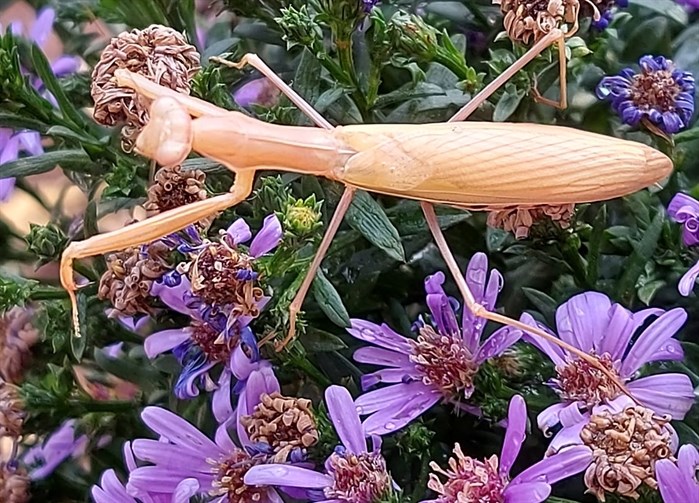Kamloops gardener expects to be startled by her own pest control experiment
An avid Kamloops gardener is trying an unusual way to control insects in her yard this summer.
Darlene Doricic hung praying mantis egg sacs on the tree in her yard six weeks ago.
“I think this is an interesting experiment and so far it seems to be working,” she said.
Doricic initially went searching for ladybugs to release into her garden to eat aphids, but when she couldn’t find those, she took the advice of a fellow gardener and bought two papery sacs containing 40 to 80 praying mantis eggs instead.
Her curiosity in the strange looking mantises and desire for finding insecticide free ways to improve her garden have kept the summer experiment interesting.
“It is impossible to tell if they have hatched and left the sac and I don’t want to handle the sac in case the mantises are not finished the process yet,” Doricic said. “I have had my eyes open for them and haven’t seen one yet, but my aphids are all gone.”
READ MORE: iN PHOTOS: Praying mantis spotted in Kamloops strikes a pose
Praying mantises are found throughout Europe, Asia, Africa, and North America where they are considered introduced. They feed on living and moving insects like grasshoppers, crickets and cockroaches, and they eat aphids too.
“We have an aphid problem and they have been tough to get rid of,” Doricic said. “I have succulent plants that I bring in during the winter. What I didn’t know is when you bring plants in from outside you have to remove the top layer of the soil because that is where the pests are.
"I ended up with an infestation in my house and unknowingly transferred the aphid problem back outside to my garden this spring.”
Aphids are common garden pests that damage plants by sucking the sap from leaves, twigs, stems, or roots.
Doricic said after the mantises hatch they will move to an area of the garden and claim it as their own territory, then snack on all of the insects there.
READ MORE: What's a garden without birds? Create habitat so they thrive
The mantises are supposed to hatch and leave the sacs between six and eight weeks after they are hung up, and she hung them up a little over six weeks ago.
Doricic said the aphids on her rose bushes have recently disappeared and she wonders if the mantises are to credit for it, even though she hasn’t spotted one yet.
She said as much as she is hoping to see the mantises in her garden, she is also a little bit nervous about them.
“They are very strange looking and quite big,” she said. “I keep thinking I’ll be out working in the garden and suddenly there will be a huge mantis staring at me and I expect it will startle me.
“I am always interested in what people are doing in their gardening. I’m curious to know how others have done using this method.”
To contact a reporter for this story, email Shannon Ainslie or call 250-819-6089 or email the editor. You can also submit photos, videos or news tips to the newsroom and be entered to win a monthly prize draw.
We welcome your comments and opinions on our stories but play nice. We won't censor or delete comments unless they contain off-topic statements or links, unnecessary vulgarity, false facts, spam or obviously fake profiles. If you have any concerns about what you see in comments, email the editor in the link above.





